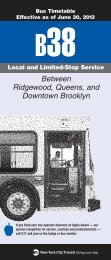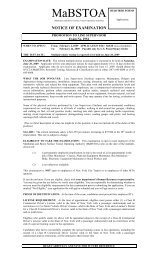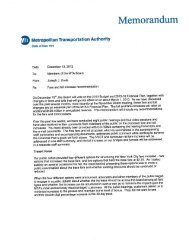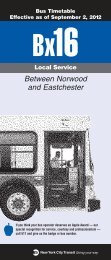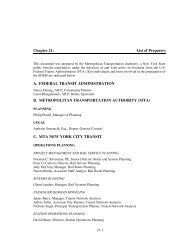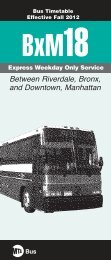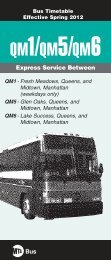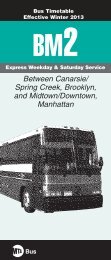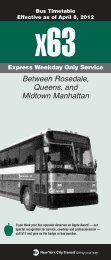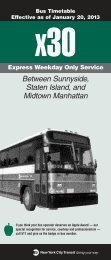Greening Mass Transit & Metro Regions: The Final Report - MTA
Greening Mass Transit & Metro Regions: The Final Report - MTA
Greening Mass Transit & Metro Regions: The Final Report - MTA
You also want an ePaper? Increase the reach of your titles
YUMPU automatically turns print PDFs into web optimized ePapers that Google loves.
<strong>The</strong> Commission recommends that the <strong>MTA</strong> agencies make a thorough examination of underutilized capacity throughout<br />
the network to identify potential projects and investments that could eliminate choke points and increase capacity.<br />
Recommendation 2. Develop a Systemwide TOD Program<br />
<strong>The</strong> <strong>MTA</strong> should develop a systemwide TOD program that articulates the principles and guidelines for TOD project<br />
development and should assist communities, developers and stakeholders throughout the region in planning these<br />
community-based initiatives. <strong>The</strong> program should proactively identify current and potential sites for TOD planning and<br />
development with smart-growth initiatives throughout the <strong>MTA</strong> service region. Each agency must be provided the funding<br />
and resources to advance this project. NYCT and Long Island Rail Road should develop in-house smart growth/TOD units.<br />
Recommendation 3. Ensure Highest Standards of Sustainability<br />
<strong>The</strong> <strong>MTA</strong> should continue to work with communities, developers, and others to ensure that TODs meet the highest standards<br />
of sustainability with respect to energy and water conservation, building materials and project design, and mitigation of and<br />
adaptation to the anticipated effects of climate change.<br />
Recommendation 4. Develop a TOD Handbook<br />
<strong>The</strong> <strong>MTA</strong> should immediately develop a handbook and online guide to support and articulate the principles and guidelines<br />
of TOD project development. This document and online resource will provide information, guidance, and contact information<br />
that will assist local officials, developers, and stakeholders throughout the region in planning community-based TOD initiatives.<br />
This guidance will also lay out the expectations and/or requirements for TODs to meet high standards for green design and<br />
CO2 reduction goals, to adapt to the anticipated impacts of climate change, to use renewable energy, to recycle materials,<br />
and to access the full range of incentives available from NYS agencies such as NYSERDA.<br />
Recommendation 5. Work with the New York State Smart Growth Cabinet<br />
<strong>The</strong> <strong>MTA</strong> should work with Governor Paterson’s Smart Growth Cabinet to examine the TOD opportunities associated with<br />
all transportation projects under development, including the Tappan Zee Bridge/I–287 Corridor <strong>Mass</strong> <strong>Transit</strong> project, the<br />
Stewart Airport expansion, Long Island Rail Road’s Main Line Corridor Improvements, and East Side Access. <strong>The</strong> State and<br />
the <strong>MTA</strong> should collaborate to make available the capital necessary to enhance the viability of these projects. Additionally,<br />
more partnering between NYSDOT, the Empire State Development Corporation, and <strong>Metro</strong>-North Railroad/Long Island Rail<br />
Road will be essential to advance regional TODs.<br />
Together, the <strong>MTA</strong> and New York State should establish a process for providing the capital investments needed for<br />
<strong>MTA</strong>-supported TODs. <strong>The</strong>se can include structured parking, bike access, shuttle buses, and related facilities at or near<br />
transit stations that can facilitate TODs, non-auto station access, and enhanced transit usage. <strong>The</strong> following list provides<br />
some illustrations:<br />
Potential TODs in the <strong>MTA</strong> service region.<br />
• West-of-Hudson: <strong>Metro</strong>-North service area: Harriman, Middletown, Pearl River, Spring Valley, Nanuet, Owen Mills<br />
(in connection with Stewart Airport and downtown Newburgh)<br />
• East-of-Hudson: <strong>Metro</strong>-North service area: Beacon, Harrison, Tarrytown, Ossining, Croton Harmon, Cold Spring, Peekskill,<br />
Poughkeepsie, Purdy, Mount Vernon, Tenmile River<br />
• Connecticut: <strong>Metro</strong>-North service area: Stamford, Georgetown-Redding, West Haven, New Haven<br />
• Long Island Rail Road service area: Ronkonkoma, Port Jefferson, Stony Brook, Bellport, Hicksville, Farmingdale, Freeport,<br />
Central Islip, Hempstead, West Hempstead, Glen Cove, Flushing, Mineola, Huntington, Babylon<br />
• New York City service area: Morris Park, Sheepshead Bay, St. Albans, Williams Bridge, Station/Gun Hill Road, University<br />
Heights Station/Fordham Road, Mott Haven/E. 149th Street, Bedford Park Yards, Wakefield Station/E. 241st Street,<br />
Melrose Station/E. 162nd Street, Woodlawn Station/E. 233rd Street<br />
39



